Stachyphrynium repens
Latin: Stachyphrynium repens (S. jagorianum)
Family: Marantaceae
Indonesian: (unknown)
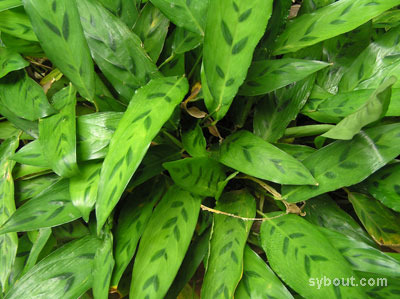
This member of the Marantaceae family has given me some problems with its identification. For a long time I thouhgt it to be Calathea leopardina or Calathea bachemiana. During a visit to the Botanic Gardens in Singapore I saw it with the name Stachyphrynium repens. From now on I will stick to that.
The species origins from the forests in the area of Indochina and Indonesia.
This plant is very suitable as ground cover in partial or full shade. Its leaves are about 15 - 25 cm in length. Plants make continuously new shoots and form clusters that are extending in time . Propagation is easily done by dividing clumps.
Though I never discovered flowers or seeds, sometimes small new plants show up in other parts of my garden. These places are always humid and shady. I still have to find out how the dispersal of this plant works.
False Heather
Latin: Cuphea hyssopifolia
Family: Lythraceae
English: False Heather, Mexican heather, Hawaiian heather, Taiwan beauty, Elfin herb
Indonesian: Tanaman Taiwan
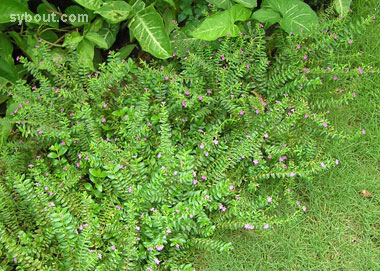
As the False Heather is native in the area from Mexico to Panama it is a mystery why it is called "Tanaman Taiwan" (Taiwan Plant) in Indonesian.
This shrub with tiny purple flowers never grows higher than 30 cm in
my garden, but should be able to reach a hight of 70 cm.
Wandering Traveler
Latin: Zebrina pendula
Family: Commelinaceae
English: Inch Plant, Wandering Traveler, Wandering Jew
Indonesian: Rumput Belang
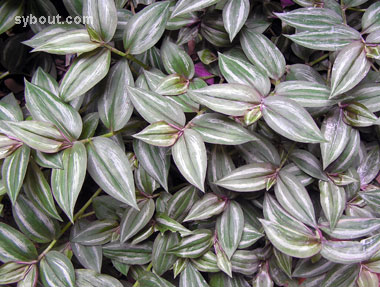
Wandering Traveler, or Inch Plant, is native to Mexico. Its leaves and
stems are fleshy. The length of the leaves is about 5 cm. The upper
site of the leaves is dark greyish-green with two bands of silver. The back site is purple
coloured. The Inch Plant develops tiny small purplish flowers that
can appear all year long.
The plants like partial to full shade with a humid, well
drained rich soil. The plants grow fast and stand pruning well.
Zebrina pendula is a good ground cover and as well suitable for growing in hanging pots.
Zebrina pendula
can easily be propagated by cuttings.
Arrowhead Plant
Latin: Syngonium podophyllum
Family: Araceae
Indonesian: (unknown)
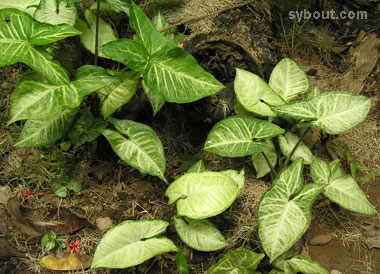
The plants in the
picture were all derived from the same mother plant, but show a clear
difference in color. Young plants often show light colored leaves,
older plants usually have plain green leaves.
Colors seem have not to be influenced that much by light or shade.
This species grows best in a shady or partly shaded place. It is very strong and can stand both dry spells and inundation. Sometimes
I take some plants as decoration in a vase inside the house. Though they get there very little light they stay fresh for months.
Synchonium podophyllum
is very suitable as ground cover. It can as well be used as pot
plant or climber.
Syngonium wendlandii
Latin: Syngonium wendlandii
Family: Araceae
English: (unknown)
Indonesian: (unknown)
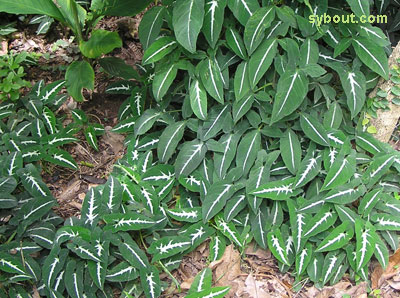
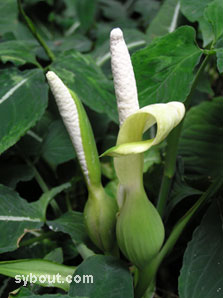
Synchonium wendlandii derives its attractiveness from the white lines on its
dark green leaves. The narrow arrow-shaped leaves have a velvet-like
surface. The plants creep with long vines and develop new roots at
the nodes. Where possible it will climb other plants, walls or
fences.
Older plants develop trifoliate leaves and occasionally some
flowers. The flowers in the photo above heave a height of 9 - 10 cm. The young leaves in the photos are about 8 - 12 cm.
The big leaflet of the
trifoliate leaves are about 11 cm long, the smaller leaflets about 6. Older leaves are less attractive as they usually
are plain green without the white lines.
Like Synchonium
podophyllum this species is suitable as ground cover. Under shrubs
and trees it can create a forest-like impression. It grows best in a
shaded or partly shaded place.
S. wendlandii can as well be used as pot plant or
climber.
Pothos
Latin: Epipremnum pinnatum 'Aureum'
Family: Araceae
English: Pothos, Variegated Philodendron
Indonesian: Sirih Gading
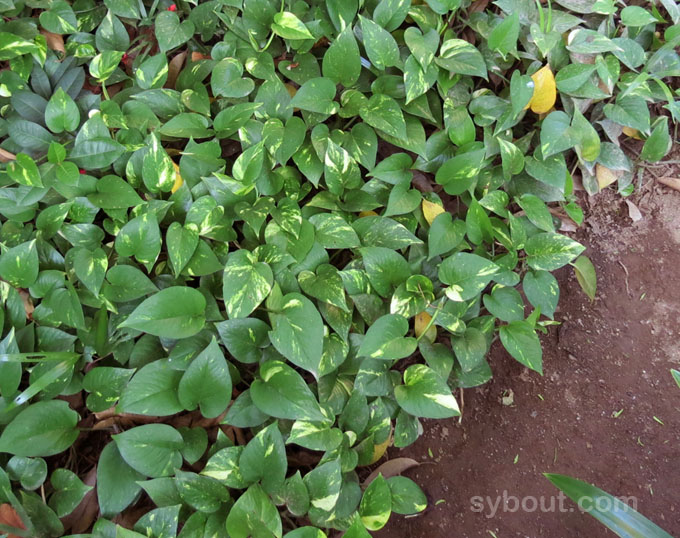
Pothos is a plant that is easily propagated by cuttings and is as well easily cultivated. Probably most people living outside the
tropics know it as a indoor pot plant. In the tropics it is often used as
ground cover under trees and shrubs, because it grows well in the
shade.
Once the plant finds a tree or wall for support it will climb and develop leaves that are more than ten times bigger than the leaves of the initial
plant (see under "Vines & Creepers").
The leaves of creeping plants are heart-shaped and yellow and white marbled. Coloring will vary with the amount of light received and with the age of the
leaves. Though Pothos likes shade, it can stand full sun for a
part of the day. At the change from the rainy to the dry season its leaves may burn and
wither, but soon new leaves will develop.